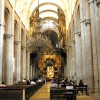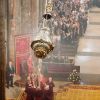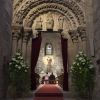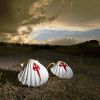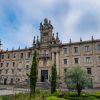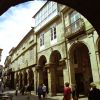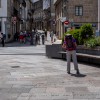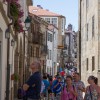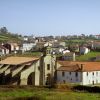- Accede I
- Regístrate I
- carrito
05. Interior de la Catedral
05. Interior de la Catedral
Galería de imágenes

La catedral recibe a sus visitantes con un interior románico presidido por el Pórtico de la Gloria. Concebido como atrio o nártex de la catedral, fue esculpido por el Maestro Mateo entre 1168 y 1188 en tan sólo 20 años. Considerado obra cumbre de la escultura románica, su misión era la de proyectar al visitante la visión apocalíptica y gloriosa del fin de los días, semejante a la Jerusalén Celeste, con “puertas siempre abiertas, en un día sin noches” (Apocalipsis 21,25).
El cuerpo central del Pórtico, presidido por un Cristo Redentor y por la figura de Santiago sedente, recibe a los peregrinos mostrando la monumentalidad y delicadeza de la obra, con más de 200 figuras de granito que componen un estudiado programa iconográfico.
Sobre la columna de mármol que representa el árbol de Jesé, los peregrinos llegados de todo el mundo dejaban constancia de su visita apoyando su mano derecha sobre dicho parteluz, expresando de esta forma su gratitud y la dicha por haber alcanzado la ansiada meta.
El ritual se completaba en la parte frontal junto a la figura del Maestro Mateo arrodillado, conocido popularmente como “Santo dos Croques”. La tradición le atribuye el poder de trasmitir su talento a quienes le den tres croques o cabezazos, costumbre especialmente popular entre los estudiantes y visitantes deseosos de inspiración.
No obstante, estos ritos han sido desaconsejados por los equipos de conservación, debido al fuerte deterioro que ha sufrido la monumental obra durante los últimos años.
En cualquier caso, aquel que lo desee, puede contemplar el Pórtico de la Gloria en todo su esplendor participando en el programa de visitas que organiza la propia Catedral de Santiago.
Avanzando por la nave central, podemos comprender el esquema de la Catedral, perfectamente conservado en su estilo románico original. Se trata de la típica planta de cruz latina de las iglesias de peregrinación, con tres naves en el sentido longitudinal y tres en el crucero. La nave central mide unos 97 metros y está coronada por un triforio que rodea todo el templo y eleva las naves hasta los 20 metros de altura. Esta galería situada en lo alto resultaba un elemento útil en la Edad Media, cuando muchos peregrinos se veían obligados a dormir en la Catedral a la espera del primer oficio religioso.
Llegados al altar mayor, percibiremos enseguida la fastuosa intervención de la arquitectura barroca en la Catedral románica. El impactante baldaquino de columnas salomónicas que protege el altar de plata y el camarín del Apóstol, está coronado por la efigie ecuestre del Apóstol. Estamos ante una obra del siglo XVII, proyectada por el Cabildo para dotar de mayor espectacularidad al conjunto de la catedral. En este punto se cumplen las máximas expectativas de los fieles, pues aquí tienen lugar todos los días la Misa del Peregrino, los ritos individuales del abrazo al Apóstol y la veneración de las reliquias apostólicas.
En efecto, subiendo por las escaleras de la derecha de la girola, en el camarín, la figura románica de Santiago, original del siglo XIII, recibe el emocionado abrazo de los peregrinos. Después, se baja por las escaleras de la izquierda para visitar las reliquias del Apóstol en el pequeño mausoleo que ha sido el epicentro espiritual de la ciudad. Esta cripta alberga los restos mortales del Apóstol, descubiertos según la tradición en el siglo IX, y que, sin embargo, reposan en una urna del siglo XIX. El motivo está directamente relacionado con una de las incursiones marítimas que, en el año 1589, el pirata Francis Drake realizó en Coruña, amenazando con llevarse las veneradas reliquias hasta Inglaterra. Los canónigos se apresuraron a ocultarlas y sólo salieron a la luz 300 años más tarde, a finales del siglo XIX, cuando una bula papal reconoció nuevamente su autenticidad.
A ambos lados del altar mayor se extienden los 65 metros del crucero, que es recorrido en fiestas solemnes por el Botafumeiro. Este enorme incensario comenzó por ser –probablemente en el siglo XII- instrumento de purificación de la Catedral compostelana, pero su verdadera función era tratar de ocultar, con el aroma del incienso, el olor corporal de los peregrinos.
El Botafumeiro, de metro y medio de altura y unos 60 kilos de peso, es accionado por ocho ‘tiraboleiros’, que lo hacen volar de norte a sur por el transepto. Basta minuto y medio para que alcance una velocidad de 68 kilómetros por hora y forme un ángulo de 82 grados sobre la vertical, lo que lo acerca hasta un escaso metro de la bóveda. La cuerda y el sistema de poleas ideado en el siglo XVI pueden verse siempre colgando de la cúpula octogonal.
Un recorrido más pausado por los brazos del crucero y la girola permitirá admirar arquitecturas, laudas sepulcrales y arte sacro de diferentes épocas, especialmente en las capillas, en las que los peregrinos de diferentes naciones encontraban a los santos de su devoción.
Antes de abandonar el templo, le sugerimos no dejar fuera de su visita la capilla de la Corticela. Fundada en siglo IX por benedictinos como oratorio fuera de la Catedral, terminó siendo unida a ella a través de un pasillo escalonado en el brazo norte, convirtiéndose en una iglesia parroquial para peregrinos y extranjeros, dentro de la propia catedral. Aunque dedicada a la virgen, nos sorprenderá en la entrada una preciosa representación de la Adoración de los Reyes Magos, así como la figura de “Cristo en el Huerto de los Olivos” en su interior, portando las oraciones y plegarias de los fieles.









